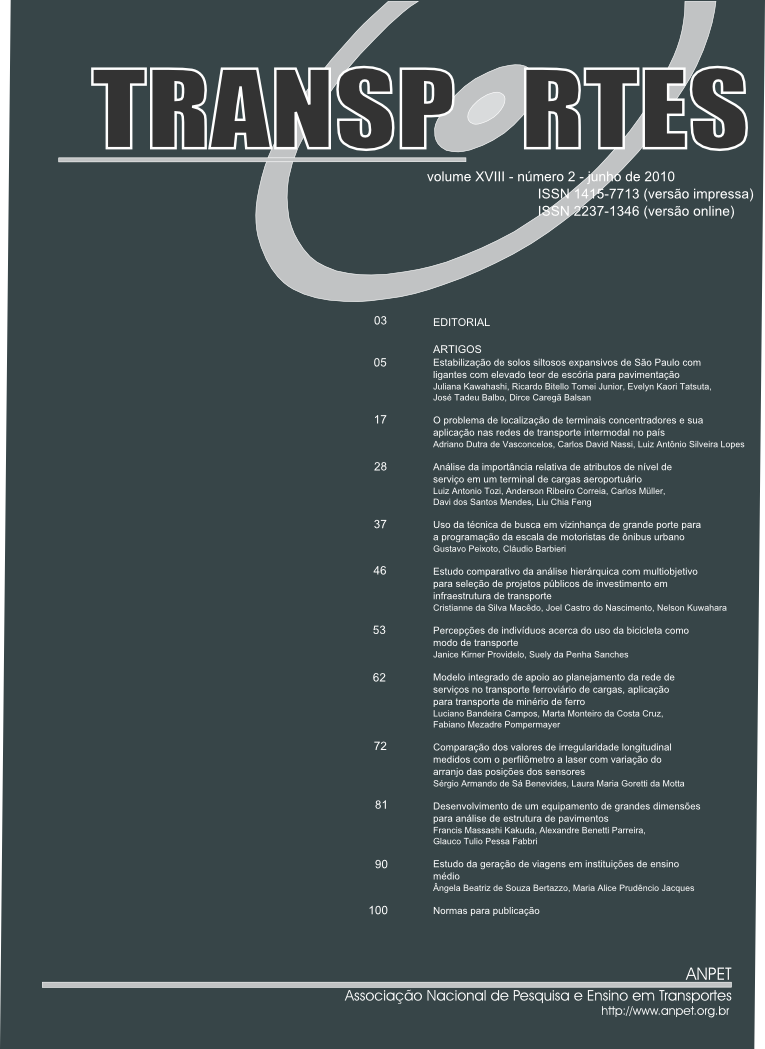Modelo integrado de apoio ao planejamento da rede de serviços no transporte ferroviário de cargas: aplicação para transporte de minério de ferro
DOI:
https://doi.org/10.14295/transportes.v18i2.425Abstract
Resumo: Apresenta-se um modelo de otimização para auxiliar o planejamento tático ferroviário com visão integrada da rede (operações em linha e pátios), e que foi aplicado ao transporte de minério de ferro numa conhecida ferrovia brasileira, considerando o efeito congestionamento. O problema é de programação não linear inteira, e a solução foi obtida por um aplicativo computacional disponível no mercado. O objetivo é facilitar o planejamento da rede de serviços: quais trens (serviços) devem ser operados, sua frequência, e a sequência recomendada das operações e serviços desde a origem das cargas até o destino. A pesquisa de literatura identificou um modelo que, mediante adaptações, foi aplicado ao fluxo de trens com diferentes opções preestabelecidas de configuração, desde 11 pontos de origem até um terminal exportador e passando por três pátios intermediários, onde os trens podem ser combinados entre si. Os resultados variam conforme a abordagem adotada para a função objetivo, com diferenças significativas na frequência dos diversos serviços disponíveis e no uso dos pátios intermediários.
Abstract: This paper presents an optimization model developed to help tactical planning at railroads with an integrated view of the network (line and yard operations). The model was applied to iron ore transportation in a well-known Brazilian railroad, considering congestion effects. This is an integer nonlinear problem, which was solved by an optimization package. The objective is to help decision making related to service network design: which trains (services) should run, how frequently and what should be the recommended sequence of activities to be performed at intermediate yards from origin to destination of cargo. Literature research identified a model that could be modified and adapted to the flow of different predefined train consist options, which are operated from 11 mines toward an export terminal. Three intermediate rail yards may be used to combine train consists. Results are presented and vary according to the objective function approach, with relevant differences in service frequencies as well as in the use of intermediate rail yards.Downloads
Downloads
Published
How to Cite
Issue
Section
License
Authors who submit papers for publication by TRANSPORTES agree to the following terms:
- The authors retain the copyright and grant Transportes the right of first publication of the manuscript, without any financial charge, and waive any other remuneration for its publication by ANPET.
- Upon publication by Transportes, the manuscript is automatically licensed under the Creative Commons License CC BY 4.0 license. This license permits the work to be shared with proper attribution to the authors and its original publication in this journal, and to be adapted for non-commercial purposes, provided appropriate credit is given and any derivative works are distributed under the same terms.
- Authors are authorized to enter into additional separate contracts for the non-exclusive distribution of the version of the manuscript published in this journal (e.g., publishing in an institutional repository or as a book chapter), with recognition of the initial publication in this journal, provided that such a contract does not imply an endorsement of the content of the manuscript or the new medium by ANPET.
- Authors are permitted and encouraged to publish and distribute their work online (e.g., in institutional repositories or on their personal websites) after the editorial process is complete. As Transportes provides open access to all published issues, authors are encouraged to use links to the DOI of their article in these cases.
- Authors guarantee that they have obtained the necessary authorization from their employers for the transfer of rights under this agreement, if these employers hold any copyright over the manuscript. Additionally, authors assume all responsibility for any copyright infringements by these employers, releasing ANPET and Transportes from any responsibility in this regard.
- Authors assume full responsibility for the content of the manuscript, including the necessary and appropriate authorizations for the disclosure of collected data and obtained results, releasing ANPET and Transportes from any responsibility in this regard.









